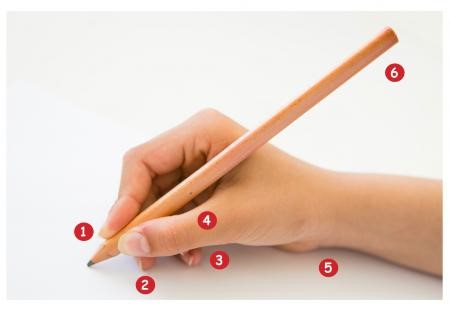Smart look up
- Teaching learners how to properly write by hand can improve their fluency in reading
- Letter-naming simply means to the shape of a letter
- Letter sound is the sound each letter name makes, represents or stands for
- Letter-writing fluency refers to how well learners automatically retrieve and write letters of the alphabets
In recent times, taking the use of technology out of our everyday life is like having a snowball’s chance in hell – impossible. However, there are limits to it. Utterly replacing handwriting with keyboarding instructions in basic, secondary and some tertiary institutions greatly affect learners’ proficiency in literacy. Teaching learners how to properly write by hand is a great big deal.
Research has it that there is a correlation between letter-naming and letter-writing fluency, and a relationship between letter-naming fluency and successful reading development. There is a strong connection between the hand and the neural circuitry of the brain—as learners learn to better write the critical features of letters, they also learn its name and sound. This recognition of letters leads to greater letter-writing fluency, which leads to greater overall reading development.
Maria Konnikova is a writer and here is what she noted about letter writing; “Not only do we learn letters better when we commit them to memory through writing, memory and learning ability in general may benefit.” I cannot agree with her any lesser. When learners practically learn how to write letters manually, they become more effective at it. Konnikova also cites a study that found that students who wrote by hand – as opposed to on a keyboard – were able to generate more ideas. Students with better handwriting demonstrated “increased overall activation in the reading and writing networks” of the brain.
Teaching handwriting
Learning how to write is a developmentally appropriate first step of handwriting instruction for learners in Pre-Kindergarten to basic 2, and having their fine motor skills developed during this period is a great starter.
Teaching and learning how to write is a step by step process that requires a lot of patience, continuity and consistency, and this can be incorporated in all areas of the curriculum throughout the school day.
To effectively teach a learner how to write well, there are four main areas to tackle: pencil grasp, formation, legibility, and pacing.
Pencil grip or grasp
This has to do with how the learner holds the writing material which usually is a pencil or crayon. Most learners hold the pencil how they may feel comfortable with or how their fingers might allow them to. Allowing the learner to hold the pencil anyhow their fingers might allow them has a lot of impact on their letter formation and eventually how their ‘hands’ turn out on paper.
The correct grip or grasps
Have the learner hold the pencil or crayon this way (even when colouring): the index finger and thumb hold the pencil against the middle finger – this is called the tripod grip. The tripod grip makes the learner comfortable and efficient at writing, while incorrect grip can cause poor letter formation and fatigue, which affects the outcome of a learners writing.
The tripod grip
If a learner is unable to properly do the tripod grip, using aids such as a pencil grip holder would be of great help. The learner can also use the ‘pinch and flip’ trick: The learner places the pencil with the writing end facing him/her, pinches the pencil between the thumb and index finger, and flips the pencil into the correct position.
Formation
This refers to how a learner goes about forming the shape of the letters. Straight lines are easier for learners to write than curved ones, so it is developmentally appropriate to teach learners to write according to the letter writing families.
It is important that letter formation instructions are given alongside letter sound instructions. This will go a long way in assisting learners with the correct way of writing letters.
Letter writing mat
For learners who struggle with letter formation, a step by step guide using the letter writing mat will be of great benefit. The mat explains or teaches learners how to form the different groups of letters – the giraffe, monkey tail and tortoise or turtle letter. The group names easily remind learners of how the letters are formed.
Learners should be taught to start their letters at the top (or middle, as is the case with some lowercase letters), and use continuous strokes as much as possible. Some letters will require that they lift up their pencils, and they should be taught how to appropriately do this.
Using visual aids as in the case of ruled lined paper is helpful. It guides the learner and gives them arrow cues for stroke direction, dots for starting points, dotted letters for tracing, etc. Learners also benefit from ‘skywriting’ letters – tracing letters in the air with an index finger while holding their arm straight out.
The letters b, d, p, and q are often very confusing when it comes to handwriting. Teaching learners their starting points is a good start to breaking that confusion, as they have different starting points – b, for instance, starts from the top, whereas d starts in the middle. Adopting the motor patterns for these letters can help make recognition more automatic.
Legibility
Legibility is simply keeping spaces between words, and this is very important and helpful.
It is helpful to encourage students to use a ‘finger space’ between words—right-handed learners can put an index finger on the line after one word before writing the next one. This technique does not work for left-handed learners, who will benefit from using a narrow tongue depressor as a spacing tool.
Pacing
This refers to the speed at which a learner writes. If learners are using the tripod pencil grip and forming letters correctly, that will often solve any pacing challenges. Another factor to consider when looking at pacing is the press: learners should not be pressing the pencil down on the paper too hard as they write because doing so can lead to writing fatigue and greatly reduce their pace.
But if they press too lightly, it can be a sign of weak muscles (of which fine motor skills development activities can help) or inappropriate pencil grip. Encouraging learners to write with a variety of materials (markers, short pencils, crayons, erasable markers on whiteboards) can also help them adjust how hard they press.
The school term is packed with instructional priorities, and this can easily overshadow the attention that handwriting needs. However, with just a few minutes a day, students’ letter formation skills can improve, leading to positive outcomes for overall literacy development.










